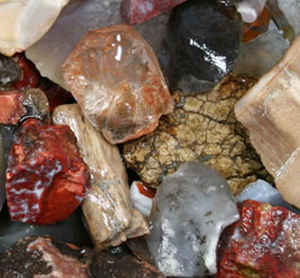
West Virginia Symbols
West Virginia State Rock
Bituminous Coal

Adopted on April 11, 2009
Bituminous coal was adopted by resolution, approved by both the West Virginia House of Delegates and the Senate. House Concurrent Resolution No. 37 was approved on April 11, 2009.
The adoption of bituminous coal as West Virginia's official state rock was spearheaded by Gilbert High School student Britnee Gibson. Her efforts to promote bituminous coal as the state rock grew out of a project she did for the CEDAR Regional Coal Fair in 2007.West Virginia is the nation's second largest producer of coal, behind only Wyoming. Britnee's father is a diesel mechanic and works for a coal hauling company according to a press release issued on April 21, 2009 by the West Virginia Coal Association.
West Virginia State Rock: Bituminous Coal

For more than 100 years, the
West Virginia coal industry has provided the economic foundation of the state's economy. The industry generates more than 20,000 direct
mining jobs and more than 70,000 indirect jobs. In addition, it generates more than $6 billion each year in total economic impact for the state.
Beyond that direct impact, West Virgnia's coal industry provides the coal to area electrical generation plants that serve to provide the state and
region with some of the lowest electric costs in the nation.
West Virginia currently ranks second among the states in coal production - only Wyoming produces more coal each year. West Virginia remains, however,
the leading coal exporting state in the nation, providing coal to more than 30 nations around the world.
In addition, the state has some of the largest coal reserves in North America or the world. West Virginia has been mining now for more than 100 years
and have only mined only a portion of the coal in the state. In fact, West Virginia have more than 200 years of coal remaining at current usage rates.
In 2008, West Virginia has produced more than 165 million tons of coal and the markets provided some of the highest prices in recent history.
In late 2008, that situation changed. The national and international economies began to slide toward recession. Prices for coal and other energy sources
plummeted and stockpiles began to grow as the worldwide recession took hold. Between the fall of 2008 and the summer of 2009, coal prices fell nearly
50 percent and demand fell.
Coal: One of the world's major sources of energy. In the United States, coal provides approximately 23% of all the energy consumed. Coal is used to produce more than half of all the electrical energy that is generated and used in the United States. Coal is a very complex and diverse energy resource that can vary greatly, even within the same deposit. In general, there are four basic varieties of coal, which are the result of geologic forces having altered plant material in different ways. These varieties descended from the first stage in the formation of coal: the creation of peat or partially decomposed plant material.
Lignite: Increased pressures and heat from overlying strata causes buried peat to dry and harden into lignite. Lignite is a brownish-black coal with generally high moisture and ash content and lower heating value. However, it is an important form of energy for generating electricity. Significant lignite mining operations are located in Texas, North Dakota, Louisiana, and Montana.
Subbituminous Coal: Under still more pressure, some lignite was changed into the next rank of coal subbituminous. This is a dull black coal with a higher heating value than lignite that is used primarily for generating electricity and for space heating. Most subbituminous reserves are located in Montana, Wyoming, Colorado, New Mexico, Washington and Alaska.
Bituminous Coal: Even greater pressure results in the creation of bituminous, or "soft"coal. This is the type most commonly used for electric power generation in the U.S. It has a higher heating value than either lignite or subbituminous, but less than that of anthracite. Bituminous coal is mined chiefly in Appalachia and the Midwest. Also used to make coke.
Anthracite: Sometimes also called "hard coal,"anthracite forms from bituminous coal when great pressures developed in folded rock strata during the creation of mountain ranges. This occurs only in limited geographic areas - primarily the Appalachian region of Pennsylvania. Anthracite has the highest energy content of all coals and is used for space heating and generating electricity.
Coal is a sedimentary rock of biochemical origin NOT Mineral
 Sedimentary Rock Type:
Biochemical
Sedimentary Rock Type:
Biochemical- Related to: Shale, sandstone and limestone
- Color: Generally black to dark brown or gray
- Texture: Amorphous and glassy to coarse fragments
- Origins: Swampy environments
- Common Minerals: Graphite , pyrite and jet (a mineraloid)
- Uses: Source of energy, lubricant, pigment and source of carbon for industrial purposes
Coal is a readily combustible rock containing more than 50 percent by weight of carbonaceous material, formed from compaction and induration of variously altered plant remains similar to those in peat [adapted from AGI's "Glossary of Geology"]. Most coal is fossil peat. Peat is an unconsolidated deposit of plant remains from a water-saturated environment such as a bog or mire; structures of the vegetal matter can be seen, and, when dried, peat burns freely [adapted from AGI's "Glossary of Geology"].
West Virginia House Concurrent Resolution No. 37
2009R2891
HOUSE CONCURRENT RESOLUTION NO. 37
(By Mr. Speaker, Mr. Thompson, and Delegates White, Eldridge, Anderson, Ashley, Barker, Boggs, Butcher, Campbell, Cann, Caputo, Carmichael, Craig,
Crosier, Ennis, Evans, Fragale, Givens, Guthrie, Hutchins, Iaquinta, Klempa, Kominar, Longstreth, Mahan, Manchin, Marshall, Martin, Michael, Moore,
Morgan, Moye, Perdue, Phillips, M. Poling, Reynolds, Staggers, Stephens, Stowers, Swartzmiller, Varner, Walker, Walters, Webster, Williams and Wooton)
Declaring Bituminous Coal to be the official state rock.
WHEREAS, From the very early days of European exploration of what is now West Virginia, the presence of coal was duly noted; and
WHEREAS, For example, in 1742 the first discovery of coal by an European explorer was made by John Peter Salley in the area now near Racine, West Virginia.
John Peter Salley, therefore, named the nearby tributary of the Kanawha River where he observed the coal deposit as the Coal River; and
WHEREAS, In 1770 George Washington noted "a coal hill on fire" near West Columbia in current Mason County; and
WHEREAS, In 1810 the first commercial coal mine opened near Wheeling by Conrad Cotts for blacksmithing and domestic use; and
WHEREAS, The coal industry has evolved into and has been for many years an integral part of the economic and social fabric of the state; and
WHEREAS, Bituminous Coal is found naturally deposited in the vast majority of the fifty-five counties of our great state; and
WHEREAS, Whereby many of those deposits have great economic importance and also where extensive mining operations are located; and
WHEREAS, Whole communities in this state rely in large part, if not completely, on the Bituminous Coal industry for their continuing vitality; and
WHEREAS, Bituminous Coal is used as a major product in the manufacturing or steel used in the many automobiles in the country; and
WHEREAS, Bituminous Coal is used in the chemical industries and in the manufacturing of hundreds of other products, such as medicines, that enhance
our quality of life; and
WHEREAS, West Virginia is the second largest Bituminous Coal producing state in the United States. For example, in 2008 there were 157,456 short tons
of Bituminous Coal mined within West Virginia; and
WHEREAS, Many experts have asserted there is another five hundred years worth of commercially viable Bituminous Coal yet to be mined within West Virginia;
and
WHEREAS, The Bituminous Coal industry remains essential to economic growth and progress in West Virginia and the United States; and
WHEREAS, It is fitting that a substance critical to the economic well-being of this great State of West Virginia and otherwise steeped in its history
as Bituminous Coal be recognized as the official state rock of West Virginia; therefore, be it
Resolved by the Legislature of West Virginia:
That Bituminous Coal is hereby designated and declared to be the official state rock; and, be it
Further Resolved, That the Clerk of the House of Delegates forward a certified copy of this resolution to Britnee Gibson, a senior, currently enrolled
at Gilbert High School in Mingo County, West Virginia.
West Virginia Law
Adopted by House Concurrent Resolution, bituminous coal is not documented as the official rock of the state in the West Virginia
Code.
Minerals, & Gems

Gemstone, Minerals, Rocks






